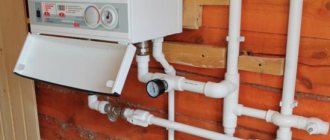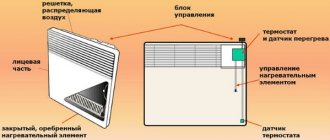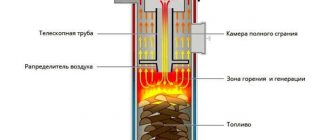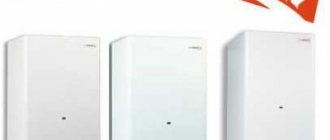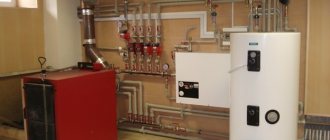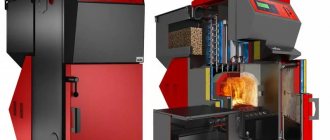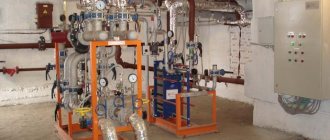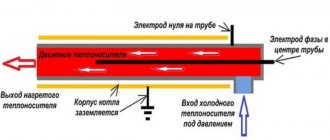Residents of apartments who have decided to abandon central heating, as well as owners of private houses, have plenty to choose from. For autonomous heating, gas and electric systems are used - boilers, heated floors, infrared and oil heaters, convectors. In medium-sized or large-sized rooms, it is advisable to install boilers that run on electricity or gas. Let's look at the first type of heaters, the features of their installation in an apartment, the rules of choice, as well as all the pros and cons that electric boilers have.
How to abandon central heating and switch to individual heating is written here.
Why is an electric heating boiler better than a gas one?
Despite the fact that gas is a cheaper source of energy than electricity, installing gas equipment is not always preferable. The main obstacles to installing a boiler of this type are:
- Difficulties with obtaining permission, coordination and preparation for installation. The room must have a properly organized ventilation system and removal of combustion products.
- High cost of equipment and labor intensive installation. And if we are talking about a private house where gas is not supplied, then the costs increase significantly.
- Potential danger of the fuel itself and its combustion products.
Advantages of electric heating systems
Electric boilers have many advantages, including:
- High reliability in terms of fire safety (of course, subject to the availability of high-quality wiring and fuses).
- Low installation costs, easy installation.
- Wide price range, choice of functions. In general, electric models are cheaper than gas models. You can choose a simple boiler, consisting of a set of heating elements and a primitive control system, which will cost very little. If there are no financial restrictions, you should pay attention to automated devices. They are able to maintain a given temperature with minimal energy consumption and have several programming modes, a GSM controller that allows you to regulate the operation of the device from a distance, and other useful options.
- Compact and aesthetically pleasing. In many modern models, all the necessary elements - a circulation pump, an expansion tank, an air vent, protection systems - are hidden inside the housing. If desired, the electric boiler can be installed in any room of the apartment. The most common are wall-mounted varieties.
- Ease of use. To control the device you only need to press a few buttons. Electric boilers do not require control or participation in their operation.
- Silence. The owners can only hear the quiet hum of the induction device or the hum of the automation units.
- There is no need for coordination with relevant organizations when the device power does not exceed 9 kilowatts.
- High efficiency.
Rating of the 5 most economical electric boilers for the home 2022
If we talk about domestic producers, we can note two leading models.
- Evan brand boilers are reliable and silent. Thermal elements are heating elements with an automatic control mode installed in the form of a seven-block unit. The heat exchanger has a unique design and is made of a single seamless piece, which ensures complete absence of leaks. The thermal circuit is equipped with a pump for circulating coolant and an expansion tank. The safety of the EC operation is ensured by a multi-level system equipped with a microprocessor unit. A 5 kW device costs approximately 30 thousand rubles.
- Another domestic and inexpensive boiler from the Galan company has a 3-level power, is capable of operating from both a regular and a three-phase power supply, is compact and light in weight. The boiler is very economical, consuming two times less kilowatts than a heating element boiler of similar power. Operating efficiency is ensured by a smooth start from modern automation.
- Geyser is considered the leader of electrode boilers in the range from 9 to 15 kW, the price indicator ranges from 3.5 to 15 thousand rubles. The plant produces a similar heating boiler “Ochag”, but slightly less powerful than the “Geyser”, as well as the “Vulcan” boiler, the latter the most powerful and can produce 50 kW of heat. One of the conditions for the operation of such EC is the technological impossibility of emergency replacement of electrodes at home; this type of work will require specialists.
- Standard Galan ECs weigh only 3 kg and have a thermal power of 3-25 kW. Manufacturers have equipped the device with a coolant temperature regulator up to 90C with the ability to heat up to 90 m2 of area.
- The Polish boiler KOSPEL EKCO also occupies a leading position among the top boilers for homes with electricity, has an almost maximum efficiency of 99% and is used for heating with radiator heating appliances, and can also be included in a circuit with a water heater for hot water supply needs. Models with a power above 50 kW operate from three-phase networks, there are two control modes - manual and automatic. The software monitors the maintenance of the coolant temperature to ensure a sanitary air temperature in living rooms. The disadvantage of this heater, as with all heating element-type boilers, is the high requirement for feed water, due to scale formation processes in the heating medium. Despite the fact that the manufacturer bothered and equipped them with filters for water purification, sometimes this is not enough to properly prepare the water. Boilers are sold in a price range depending on power from 15 thousand rubles. up to 30 thousand rubles
- Rusnit 209M is a small energy-efficient boiler with a power of 9 kW, capable of heating an area of 90 m2. The good layout of the EC ensures easy installation, the boiler is fully automated with an accuracy of 0.5 C and has protection against water overheating. Operating experience suggests that the boiler has been operating without failures for several years.
Disadvantages and difficulties of operating electric boilers
The advantages of electric boilers look attractive. But they also have disadvantages, and very significant ones.
- High cost of electricity.
Note! Costs can be reduced several times by insulating the apartment, using preferential electricity tariffs and choosing a device with precise adjustment.
- Requirements for the type of radiators. In an electrically heated system, it is uneconomical to use cast iron and steel batteries. It is advisable to choose bimetallic or, as a last resort, aluminum heating devices.
- Complete dependence on power supply.
- Demanding on the quality and composition of the coolant.
- When installing equipment that consumes more than 9 kW, instead of a standard 220 V network, a three-phase 380 V network will be required. If the apartment does not have one, you must obtain special permission for the installation, which is not always possible in old houses.
USEFUL INFORMATION: What color to paint the walls in the kitchen
Before you decide to purchase and install an electric boiler, you need to weigh all the pros and cons, calculate the approximate electricity consumption per month and think about how significant it will be for the budget.
Selection and recommendations
There is a sufficient selection of domestic and foreign equipment on the market, so it is worth deciding in advance on the type and characteristics of the future boiler. Energy-saving electric boilers have several properties that should be taken into account when choosing a heating system.
The choice is determined by the following key characteristics:
- Efficiency . Standard energy-saving boilers have an efficiency level of about 98%, and automatic control contributes to the optimal level of heat production.
- A design that can be easily matched to a specific room interior.
- Functionality . The line includes models with instant heating. This heating of the coolant increases efficiency and simplifies the adjustment of boiler power. Also, each model has its own additional options that help improve the control and operation of the boiler. It is worth considering that the price also depends on the number of additional sets of options - the more there are, the higher the cost of the model.
The small size of the equipment allows you to fit an electric boiler into any room Source ultra-term.ru
- Warranty and service life . When purchasing certified equipment, the client is issued a guarantee, which indicates the period of warranty operation, and also informs about the features of repairing the equipment in the event of a breakdown. You must understand that the warranty period and service life are different concepts. So, if the warranty period is 10 years, this means that the device is guaranteed to work for this period, or it will be repaired for free. And the service life can exceed the warranty and be 20, 30 or more years.
- Manufacturer and brand of boiler . You can choose an energy-saving heating boiler for a private home not only according to preferences, but also according to reviews from real users.
The choice of boiler is made in accordance with the required characteristics. It is worth paying attention to the price segment, since different models with the same set of functions have different prices. Most often this is due to the manufacturer and materials used in the manufacture of the boiler.
A large number of positive reviews confirm the effectiveness of using this type of autonomous heating. Users emphasize the ease of installation of equipment, ease of control and reliability of electric boilers.
Electric boilers with heating elements (tubular heaters)
Such boilers work on the same principle as most household electrical appliances - kettles, boilers, irons. They are most in demand among consumers and are presented in a wide variety of models. There can be several heating elements, and they are turned on together or alternately.
Pros:
- simplicity of design;
- reliability of the circuit, ease of repair.
Minuses:
- high inertia of boilers - slow heating at startup;
- demands on the quality of the coolant. The tendency for scale to form, which reduces heating efficiency, forces special measures to be taken. You can install anode rods that will collect salt deposits on themselves, and change them at certain intervals, just like the heating elements themselves. But it is better to use specially prepared water or a special coolant.
Operating principle of an electric boiler
Almost all electric boilers operate on the same principle: a heating element is placed in the heat exchanger, which, after applying electric current to it, begins to generate heat. The coolant entering the heat exchanger (usually simple tap water, and in closed heating circuits water with special additives or antifreeze) is heated after contact with the heating element.
By the way, water can be heated not only by a traditional heating element (that is, a heating coil enclosed in a protective casing), but also by induction or electrode methods. However, it is electric boilers with heating elements that are most widespread, both among imported and domestic models.
heating circuit
The power supply for heating boilers is also very diverse. They can be powered from standard household 220 volts, or they can have industrial power supply with three phases at 380 volts. There are even modifications that are powered by batteries.
Induction devices
Induction boilers are energy-efficient and reliable devices that can operate for years without maintenance or repair.
Pros:
- thanks to the phenomenon of self-induction, they significantly save energy (up to 30% during the heating season);
- undemanding to the composition of the coolant (scale does not appear in such boilers);
- service life - from 30 years, the likelihood of breakdown due to the design features is very low;
- quick heating of the coolant;
- possibility of precise adjustment.
Minuses:
- large mass (from 30 kg) - strong brackets are used for hanging, the wall must be able to withstand the load;
- circulation pump, expansion tank, safety group are purchased and installed separately;
- relatively high cost;
- vibration noise during operation.
Basic elements of electric boilers
Regardless of the power of the electric boiler and its main purpose, it consists of the following main elements:
- The housing, which serves as a container for all components.
- A heat exchanger, which serves to transfer heat from the heating element to the coolant tank,
- Control, control and adjustment units.
A number of models of electric boilers may also have built-in circulation pumps to ensure the movement of coolant, and valves that redirect its flow.
A modern electric boiler is a high-tech device that heats flowing water with maximum efficiency, while operating in a completely autonomous mode. Even a child can operate such equipment - it is so safe and simple. Also, modern electric boilers have a fairly high efficiency, which will allow you to avoid unnecessary bills for wasted electricity.
water supply distribution
There is a great variety in the design of such electric heating devices. They come in a variety of shapes, with wall or floor placement.
Ionic (electrode) heating boilers
Such devices heat the coolant by applying voltage through the electrodes, resulting in the ionization of molecules and their movement towards a conductor with a different polarity. In a single-phase network, one electrode is used in the form of a rod, the second is the surface of a metal cylinder, with three-phase voltage - 3 electrodes.
USEFUL INFORMATION: Fashionable kitchen: choosing ceramic tiles for the backsplash
The sizes of ion boilers vary from very small ones, capable of heating only one battery, to large installations designed for a large house. Available both with and without casing.
Pros:
- compactness. The device without a housing takes up little space;
- high-speed heating of the coolant;
- low inertia, allowing very precise adjustment;
- resistance to voltage surges;
- high level of safety - if there is no coolant in the boiler, it simply cannot work;
- low price (without control unit, pump and expansion tank).
Minuses:
- complete incompatibility with batteries made of steel and cast iron;
- demands on the quality of the circulating fluid, which must have a balanced composition. It is recommended not to make it yourself, but to purchase a ready-made one;
- the need for a specialist to check the condition of the coolant before the new heating season;
- special requirements for the grounding loop;
- heating temperature – no higher than 75 °C;
- the need to replace electrodes at certain intervals.
Installation nuances
Having selected the equipment, you can begin its installation.
Basic Rules:
- all installation and connection work must be carried out by a service center specialist;
- you need to be sure that the wall on which the device is hung will support its weight;
- There must be free space around the boiler for maintenance.
As a rule, the recommended distance from the side walls of the boiler to the furniture is indicated in the device instructions. The material of the wall to which the unit is attached must not be flammable. The device should hang evenly, without distortions.
The installation procedure is as follows:
- First, the mounts are mounted on the wall. The device is installed on them.
- Grounding work is being carried out.
- The boiler is connected to the heating system.
- Commissioning works are being carried out. The leaks are checked, excess air is bled off, and the system is tested in different temperature conditions.
Experts recommend contacting certified companies for connection. The warranty on many devices may be voided if installed improperly. Induction heating boilers you will find the answer in the link.
Single-circuit and double-circuit boilers: what is the difference?
Let's look at the differences between the two modifications of these units.
- Single-circuit boilers are designed only for heating the room. At the same time, an indirect heating boiler can be connected to all modern boilers and hot water supply can be provided.
- Double-circuit, in addition to participating in the heating system, heat water for domestic needs. Their design provides an additional heat exchanger, which can be flow-through or storage - in the form of a built-in water heating tank.
Note! A double-circuit boiler cannot operate on 2 circuits at the same time. When you open a hot water tap, heating of the heating fluid stops.
Let us briefly describe their advantages and disadvantages.
Advantages of a single-circuit boiler:
- relatively low cost;
- high efficiency and high power;
- lower energy consumption (no boiler).
Minuses:
- if necessary, you will have to install an additional boiler to heat water;
- together with an indirect heating boiler, the design looks bulky and unaesthetic.
Advantages of a dual-circuit device:
- quite compact size;
- easy installation.
Minuses:
- instability of water pressure and temperature;
- high requirements for coolant quality and maintenance;
- high cost.
Note! If we compare the prices of a double-circuit boiler and a device with one circuit and an additional boiler, the first will cost less.
It's difficult to say which boiler is better. If it is important to save energy, as well as space in the apartment, you should choose a double-circuit version. This device heats water only when it is needed; the single-circuit device will turn on every time the liquid cools down. At the same time, a single-circuit boiler is considered more reliable and convenient to use.
Advice. If your automated boiler has an additional storage tank, it can be programmed to heat water at night when electricity rates are lower. During the day, when the cost of electricity is higher, you can use already heated water.
Types of boilers by installation method
Depending on the installation method, the devices can be floor-mounted or wall-mounted. Each type has its own characteristics.
Floor-standing
Floor-standing systems produce more power than wall-mounted ones. Such boilers are designed for heating large cubic capacity. Therefore, they require a separate room for installation. The boiler room can be installed in the basement. In addition, the floor-standing model can be double-circuit, that is, in addition to heating, it can heat water for domestic and household needs, and work as a boiler. The electricity consumption of such a device is higher.
Wall mounted
Wall-mounted boilers are more compact and can be hung in the bathroom or kitchen. They look quite decent and also consume much less electricity than floor-standing ones. Suitable for small houses. Such a unit will be single-circuit, producing either heat or hot water.
Power
The power of the boiler is its most important characteristic, which means you need to choose it correctly. Sometimes it is tied to the footage and calculated based on the value of 1 kW per 10 m2. This formula is only suitable for a very rough estimate.
USEFUL INFORMATION: What types of electrical outlets are there?
In fact, you need to focus on heat loss. If, for example, they are 8 kW, then you need a boiler of the same power. The calculations take into account:
- area and height of the room;
- degree of insulation of walls, floors, ceilings;
- the number of external walls and their location according to the cardinal directions;
- number, dimensions and type of windows;
- battery connection diagram;
- region of residence and other parameters.
To correctly calculate the boiler power, it is recommended to use special calculators or seek advice from a heating engineer.
What to look for when choosing
First of all, you should focus on the power of the unit. It is important to know the permissible load on the electrical network, since each home has its own standard. The efficiency of a heating system depends on power, and increasing it leads to increased load.
The standard ratio of the specific power of the boiler and the heated area: 1 kW of power is needed per 1 m².
In addition, the following factors play a role when choosing:
- It is necessary to take into account the specific heat losses of the house during the heating period. These are complex calculations. Before installation begins, all heat leaks in the room must be eliminated. It is known that a house loses up to 1/5 of its total heat reserve through old windows, the same amount of heated air escapes through cracks in doors, and an uninsulated floor leads to a loss of 1/10 of the heating effect.
- It is necessary to determine the area of the installation site and, based on this, the dimensions of the unit. If it is a wall-mounted device located in the visible area, then it must have a suitable design.
- Many models involve electronic or mechanical control. Electronics are more expensive.
The most important thing is the ratio of the boiler’s capabilities to its cost.
Additional functions
The following functions of electric boilers may be useful:
- protection systems – from overheating, short circuit, overpressure;
- the ability to install a GSM controller, which will allow you to remotely adjust the temperature in the apartment, change the boiler settings, and send notifications about possible problems;
- a control unit with energy-saving modes that allow you to reduce the temperature at certain periods of time - at night, when residents are not at home;
- smooth power adjustment. This option is more convenient and profitable than the stepped one.
Note! Often control units are not included in the package of electric boilers. In this case, they will have to be purchased separately.
How to choose an electric boiler for heating a private house and calculate the required power.
In order to correctly choose an electric boiler model for heating and hot water supply to your home, you first need to determine the required power of the electric boiler. There are both modest wall-mounted electric boilers with a capacity of 2.5 kilowatts and stationary installations, the effective power of which is measured in tens of kilowatts.
To calculate the required power of an electric boiler, you can use a fairly simple formula - divide the area of the heated premises by 10. The resulting figure will show the required power of the electric boiler in kilowatts. So, if you plan to heat a house with an area of 90 square meters using an electric heating device, then the minimum required power of the electric boiler will be 9 kilowatts.
Factors such as the material from which it is built, the degree of insulation and external climatic conditions will significantly affect the energy consumption figure for electric heating of premises. All this can make significant adjustments to the required power. Automating the heating process can also significantly reduce energy consumption - maintaining several temperature modes, automatically switched by timer. In this case, the heating will not provide maximum heating during your absence, but will only maintain the minimum required temperature level.
Cost of electric boilers
The price range for electric heating boilers is as wide as their model range. The price of such devices depends on both the power and the functions implemented. In addition, the final cost of installing an electric heating system is significantly influenced by the purchase of additional equipment.
A small wall-mounted device costs several thousand rubles, which can provide an acceptable temperature in a small country house, but for an apartment building the price of such equipment will already be several tens of thousands of rubles.
Popular models
Among the variety of brands, the leading positions in the ranking are occupied by the following manufacturers:
- Protherm (Slovakia),
- Vaillant (Germany),
- Kospel (Poland),
- Buderus (Germany).
Among Russian brands, buyers give preference to 4 brands, including:
- "TEPLODAR"
- "EVAN"
- ZOTA,
- "RusNIT".
The best models from the category of medium-power boilers that are suitable for apartments, based on user reviews:
- Teplodar Sputnik 6 (8.1 thousand rubles);
- RusNit 208M (average price - 16 thousand rubles);
- EVAN Warmos-IV-5 (16.5 thousand rubles);
- ZOTA 12 Lux (RUB 21.4 thousand);
- Kospel EKCO L2 12 (37 thousand rubles);
- Protherm Skat 12 KR 13 (32.5 thousand rubles);
- Vaillant eloBLOCK VE 12 (35 thousand rubles);
- Buderus Logamax E213-10 (9.3 thousand rubles).
Teplodar Sputnik 6 in black
Teplodar Sputnik 6 in white
Review of popular manufacturers and cost
There are several large manufacturers on the Russian market that offer different models of devices. Energy-saving electric heating boilers and their prices are presented in the following review.
Galan
The Russian company produces electrode devices in three modifications. “Ochag-3” is designed for 3 kW, its average price is 9,600 rubles. “Ochag-6” (6 kW) costs 11,500 rubles.
Prices for electric boilers Galan
galan boilers
EOU
An energy-saving heating system (as the abbreviation in the title stands for) is an innovative development of Russian scientists. 1 kW of power heats 20 m². Manufacturer's warranty: 10 years. The cost of a model with a power of 5 kW starts from 3,900 rubles. EOU can be purchased in Moscow or ordered delivery to the regions.
EnergoLux
The devices of the Ukrainian company EnergoLux are equipped with wireless temperature sensors and climate control. Each radiator is an independent device for a separate room. Available in premium and elite models. EnergoLux Premium-1500PU/12 can be purchased for 9,400 rubles, EnergoLux Elite-1500PUT/15 - for 12,200 rubles.
Savitr
Another Russian one produces models designed for rooms of different sizes.
There are the following modifications of heating units:
- SAVITR M1EB1MS003 Mini (cost 3,400 rubles);
- SAVITR M1EB1CS004N Classic 4 (price 9,900 rubles);
- SAVITR M1EB3SO004 Optima 4 (19,000 rubles).
Prices for electric boilers Savitr
Savitr boilers
Advantages and disadvantages
Before deciding which electric boiler to choose, you need to familiarize yourself with the advantages and disadvantages of devices of this type.
Pros:
- There is no need to obtain permission to connect from technical supervision authorities.
- Relatively low cost.
- High efficiency (efficiency up to 99%).
- Easy to install.
- Easy to use and care.
- Ability to regulate temperature.
- Safety for humans.
- Small sizes.
- Environmentally friendly.
- Quiet operation.
- Variety of models.
Flaws:
- Operating such a boiler will cost a pretty penny.
- The need for electricity.
- The need to install special three-phase wiring if the device has a power of more than 12 kW.
How to save on electricity in an apartment?
Thermostats help to significantly save energy consumption. Thanks to them, it is possible to determine the optimal temperature regime and not overuse the resource. Additionally, it is also recommended to use a multi-tariff meter. With its help it will be possible to reduce consumption at night. Heat can escape through walls or windows. That is why they should be carefully insulated. Proper thermal insulation can save up to 40%.
Smart home heating system
The concept of a “smart” home (smart house, or Intellhouse) is becoming increasingly widespread in the world. In a general sense, a “smart” home is a unified system of heating, lighting, ventilation, alarm, as well as monitoring and automatic control of all engineering systems. This includes smart plugs, thermostats, security cameras, locking mechanisms, and turning consumer electronics on and off. “Comfort management” in such a house is given a central place.
Autonomous and decentralized heating is still most typical for private houses. Well-designed buildings not only symbolize the owner’s commitment to high technology, but also contribute to very real savings. Experts from MiDart, for example, point to a reduction in operating costs by 30%, and in heating costs by 50%. What “features” of smart boilers are used to achieve such savings?
Installation in an apartment of an apartment building
When installing electrical equipment, it is recommended to adhere to the following rules:
- The negative effect of drafts can be minimized if convectors are installed under the windows.
- For optimal heating, buy an in-floor option.
- The equipment must not be operated without grounding.
- Warm floors are best installed in the kitchen and bathroom.
- To regulate the intensity of work, thermostats are installed.
- Oil heaters are rarely used in city apartments. This option is ideal for a country house.
Electric heating of the house - the basic principle of operation
Manufacturers offer a wide range of heating systems that run on electricity. Their work is based on the Joule principle. When current is connected, it flows to the heating element. Additionally, resistance arises in the system. However, some of the energy manages to create heat. In this case, it is also possible to achieve a partial reduction in voltage. By making changes to the connection diagram, it is possible to take control of the level of heat transfer. A conductor is a spiral or thread that consists of a refractory metal.
The heating level directly depends on the current strength in the network. However, you will additionally need to take into account the resistance value and operating time of the device.
Types of heaters for heating systems
Despite the market diversity, water heating units, depending on what raw material is fuel, are divided into the following types:
- Gas. This is the most common type due to its efficiency and relative cheapness of fuel.
- Solid fuel. These water heating boilers are common in rural areas and areas remote from gas mains.
- Liquid fuel. They are the least popular because they are complex and expensive to operate.
- Electrical. Popular among urban users. They are distinguished by their efficiency, but also by the high cost of fuel - electricity.
- Combined. This is a universal type of heater that helps control fuel costs depending on market conditions.
According to their purpose, water heaters are divided into the following:
- Single-circuit, providing exclusively heating.
- Double-circuit, which additionally provide hot water for personal needs.
According to the method and location of installation, they are divided into wall-mounted and floor-mounted. Some are produced exclusively in a floor-standing version, for example, running on liquid and solid fuel.
Heating boilers Buderus
Each variety has different characteristics that will have to be taken into account when installing autonomous heating.
How to install an electric boiler in a private house yourself (diagram)?
Modern electric boilers, despite all their high-tech, are quite simple devices to install. A schematic diagram of the installation of a typical electric heating boiler is shown in the figure.
electric boiler installation diagram, necessary system elements
However, as the design of the boiler becomes more complex and additional circuits are included in the heating system, the installation of such devices also becomes more complicated. Developed systems include not only heating circuits (of which there may be several according to the number of rooms in the house), but also a hot water supply circuit. Each circuit can be equipped with individual temperature sensors, drain and shut-off valves, an inlet filter for coolant water, and circulation pumps.
Therefore, the installation of a heating system based on an electric boiler in a private house must begin with drawing up a detailed project. The project must reflect the required power of heating electrical equipment, calculate the required number and length of pipelines for organizing the circuits of heating and hot water supply systems, as well as all peripheral equipment.
Important!!! If you start installing a heating system without first assessing power consumption and developing a project, you may make a critical mistake and end up with either a cold house or excessive electricity consumption. In this case, you are unlikely to be able to save money ! Any mistake in calculations will hit your pocket hard!
After drawing up the project and calculating the power, the power supply system is reviewed - if necessary, new wires are laid, and a separate emergency switch is installed in the distribution panel.
In the future, the installation of the heating and water supply system is carried out according to the general rules for the construction of such systems. When installing yourself, at least at the stage of calculation and drawing up the project, we recommend that you take advantage of specialist consultations.
Heating electric boilers - the traditional choice
The production technology of devices of this type has gone through several stages of improvement. They are as convenient as possible, inexpensive and will last for a long period of time. The heating element unit is characterized by the following advantages:
- The heating coil quickly releases heat.
- The heating element can be replaced separately if it fails.
- High degree of reliability and minimal risk of emergency situations.
The building can be heated within 15 minutes after starting the electric boiler.
Solid fuel boilers
This is a popular type of boiler among home owners. Used for heating in rural areas or in places where firewood, pellets or coal are inexpensive and freely available.
Pellet water heater design
- Type of fuel. Wood is used as fuel - firewood or pellets, as well as coal. There are mixed-type boilers with several fireboxes.
- Method of fuel combustion. Classic, long-burning and pyrolysis are available.
Pellet versions are popular, providing a high level of automation with long-term programming of operating modes. These are the most modern water heaters in the solid fuel family in terms of fuel type.
In a classic solid fuel boiler, heat is generated by simply burning wood, like in a stove. Hence all the disadvantages of such units - they will have to be cleaned, monitored for smoke removal, constantly adding firewood and regulating the combustion force and draft with a damper, etc. In principle, we are not talking about any autonomy. Efficiency does not exceed 75%. The advantage lies in reliability, simplicity of design and wiring diagram, independence from electricity and low cost.
Long-term or top-burning water heaters use a different method of loading fuel - from above. Due to this, complete combustion occurs and efficiency increases.
Construction of a pyrolysis boiler

